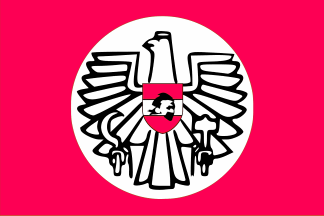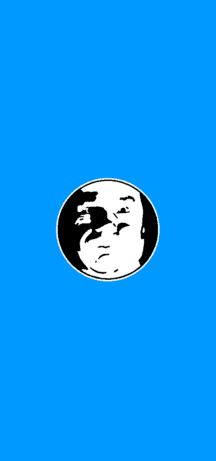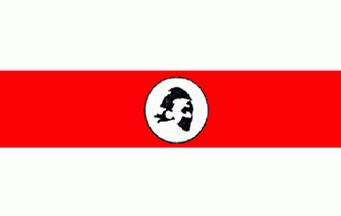 image by Olivier Touzeau,
2 August 2017
image by Olivier Touzeau,
2 August 2017
Last modified: 2022-12-27 by martin karner
Keywords: austria | kugelmugel | vienna |
Links: FOTW homepage |
search |
disclaimer and copyright |
write us |
mirrors
 image by Olivier Touzeau,
2 August 2017
image by Olivier Touzeau,
2 August 2017
See also:
The Republic of Kugelmugel is a micronation located at the Prater in Vienna, Austria. The Republic declared independence in 1976, after disputes between artist Edwin Lipburger and Austrian authorities over building permits for a ball-shaped house which he erected at the Landesstraße 4091 in Katzlesdorf, Lower Austria in 1971. In 1979, Lipburger was arrested and sent to jail for ten weeks.
In June 1982, the house was moved into the Prater park, near the Hauptallee, and
enclosed by eight barbed-wire fences. The house has the only address within the
proclaimed Republic, that being "Antifaschismusplatz 2" ("Anti-Fascism Square"
No. 2), which has since been officially adopted by the city of Vienna. Lipburger
died in January 2015, but the Republic officially holds a population of over 650
non-resident citizens. Nowadays, the Republic is administered by Vienna's
government and used as a tourist attraction.
Source:
https://en.wikipedia.org/wiki/Kugelmugel
The flag of Kugelmugel can be seen in a article published in the Wiener
Zeitung on 2007, May 15th,entitled "Kugel-Republik kontra Hauptstadt"n by
journalist Mathias Ziegler. The photograph is labelled "Generalvolksanwalt"
Lipburger in seiner Republiks-Kugel.
See:
http://www.wienerzeitung.at/nachrichten/wien/stadtleben/269988_Kugel-Republik-kontra-Hauptstadt.html
The flag is pinkish red with a large white disk in the middle, on which
are the full arms of the Republic: an Austrian-style stylized eagle in black in
white with an escutcheon gules, a bar argent with the black silhouette of
Mr.Lipburger overimposed.
The flag was published in Royaumes d'aventure
by Bruno Fuligni.
Olivier Touzeau, 2 August 2017
Several photographs [1,2] show the "state emblem", being a silhouette of
Lipburger in black on a white circle, usually put on a red square. It is used on
"embassy" signs as well as on general signs.
The state emblem was originally reported as
"state arms" in Flag Bulletin [5], however without the red field on which it is
currently shown. The same article [5] reports and shows a sketch of the flag as
being a hanging flag, ratio 32:15, showing on a light blue field a disk with
Lipburger's face in black-and-white, surrounded by a narrow white ring. The
explanation given by Lipburger to the author of the article was: "light blue
reflects the spirit of his philosophy whose center, the Kugel, is
symbolized by the disk on the flag". The effigies of Lipburger on the arms and
the flag are very much different. During a court sentence against Lipburger, his
sympathizers waved the flag before the court [5]; I guess, this was a different,
smaller and horizontal
version of the flag, though.
 image by Christian
Kretowicz, 14 October 2009
image by Christian
Kretowicz, 14 October 2009
Unfortunately, the author of the Flag
Bulletin article does not disclose his sources, except for the casual mentioning
of a personal encounter with Lipburger. The exact depiction of the flag with an
exact-looking ratio implies that he has actually seen (and probably
photographed) the flag.
Sources:
[1]
http://www.flickr.com/photos/gtavares/237267460/
[2]
http://www.flickr.com/photos/dugspr/1691559185/
[3]
http://www.flickr.com/photos/incommodities/3804831120/
[4]
http://www.flickr.com/photos/hansl/2086718982/
[5]
Guarghias, AG (1993) The Rolling Republic of
Kugelmugel. Flag Bulletin 150 (XXXII:1): pp. 57-61.
M. Schmöger, 14 October 2009
 image by Christian
Kretowicz, 14 October 2009
image by Christian
Kretowicz, 14 October 2009
The state emblem is also
shown on "border signs", which are horizontally divided white-red-white with the
emblem in the central red stripe [3,4]. My putative interpretation of this
design would be:
- "inverted" Austrian colours, i.e. instead of red-white-red
- reference to the white/red chevrons used at the border post, as frequently
done on other border posts.
Olivier Touzeau, 2 August 2017